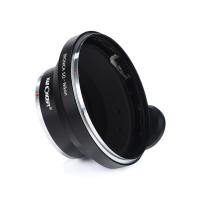How To View Cheek Cells Under Microscope ?
To view cheek cells under a microscope, you will need a microscope, microscope slides, coverslips, a cotton swab, and a stain (such as methylene blue). Start by gently swabbing the inside of your cheek with the cotton swab to collect some cells. Then, smear the swab onto a clean microscope slide. Allow the slide to air dry completely. Once dry, fix the cells by passing the slide through a flame a few times or by using a fixative like ethanol. Next, add a few drops of the stain onto the slide and let it sit for a few minutes. Gently place a coverslip over the stained cells, being careful to avoid any air bubbles. Finally, place the slide on the microscope stage and observe the cells under low magnification first, then gradually increase the magnification to get a closer look at the cheek cells. Adjust the focus and lighting as needed to get a clear view.
1、 Preparation of cheek cell slide for microscopic observation
To view cheek cells under a microscope, you will need to prepare a cheek cell slide for microscopic observation. Here is a step-by-step guide on how to do it:
1. Start by washing your hands thoroughly to ensure cleanliness and prevent contamination of the slide.
2. Gently swish your mouth with water to remove any food particles or debris. This step helps to obtain a clear sample of cheek cells.
3. Take a clean cotton swab and gently scrape the inside of your cheek. Be careful not to apply too much pressure to avoid causing any discomfort or injury.
4. Transfer the collected cells from the cotton swab onto a clean glass slide. You can do this by gently rubbing the swab onto the surface of the slide.
5. Add a drop of a staining solution, such as methylene blue or iodine, to the cells on the slide. This will help to enhance the visibility of the cells under the microscope.
6. Place a coverslip over the stained cells on the slide. Be careful to avoid trapping any air bubbles between the slide and the coverslip.
7. Carefully place the prepared slide onto the stage of the microscope and secure it in place.
8. Start with the lowest magnification objective lens and focus on the slide by adjusting the focus knobs. Gradually increase the magnification to get a closer look at the cheek cells.
9. Once you have achieved a clear view, observe the slide under the microscope and note the characteristics of the cheek cells, such as their shape, size, and arrangement.
It is important to note that this procedure is for educational purposes only and should be conducted under the supervision of a trained professional. Additionally, always follow proper safety protocols when handling microscopes and staining solutions.
In recent years, advancements in technology have allowed for the development of digital microscopes and smartphone attachments that can capture images and videos of cheek cells. These tools provide a convenient and accessible way to view and analyze cheek cells without the need for traditional microscopes.

2、 Adjusting microscope settings for optimal cheek cell visualization
To view cheek cells under a microscope, follow these steps:
1. Prepare a slide: Take a clean glass microscope slide and place a drop of water in the center. Gently scrape the inside of your cheek with a clean cotton swab or the edge of a toothpick. Swirl the swab or toothpick in the water droplet to collect cheek cells. Mix the cells in the water to create a suspension.
2. Mount the slide: Using tweezers, carefully place a coverslip over the water droplet on the slide. Press down gently to avoid crushing the cells but ensure the coverslip is firmly in place.
3. Adjust the microscope: Start with the lowest magnification objective lens (usually 4x or 10x) and place the slide on the microscope stage. Use the coarse adjustment knob to bring the cells into focus. Once roughly focused, use the fine adjustment knob to sharpen the image.
4. Optimize lighting: Adjust the light intensity using the microscope's condenser or diaphragm to achieve optimal illumination. Too much light can wash out the cells, while too little light can make them difficult to see.
5. Observe and adjust magnification: Once the cells are in focus, switch to higher magnification objective lenses (40x or 100x) to observe the cells in more detail. Use the fine adjustment knob to refocus as needed.
6. Take notes or capture images: If desired, use a camera attachment or smartphone adapter to capture images of the cheek cells. Alternatively, take notes on their appearance, shape, and any other observations.
It is important to note that this process may vary depending on the type of microscope being used. Always refer to the manufacturer's instructions for specific guidance.
In recent years, advancements in microscopy technology have allowed for even more detailed visualization of cheek cells. Techniques such as fluorescence microscopy, confocal microscopy, and electron microscopy have provided researchers with the ability to study cellular structures and functions at a molecular level. These advanced techniques have contributed to a deeper understanding of cell biology and have opened up new avenues of research in fields such as genetics, immunology, and cancer biology.

3、 Identifying and distinguishing different types of cheek cells
To view cheek cells under a microscope, you will need a few basic laboratory supplies and a microscope. Here is a step-by-step guide on how to do it:
1. Start by collecting a sample of cheek cells. Gently scrape the inside of your cheek using a cotton swab or a clean toothpick. Make sure to be gentle to avoid any discomfort or injury.
2. Transfer the collected cells onto a clean glass slide. You can do this by gently rubbing the swab or toothpick onto the surface of the slide. Spread the cells evenly across the slide.
3. Allow the slide to air dry completely. This will help prevent any distortion or damage to the cells during the staining process.
4. Once the slide is dry, you can stain the cells to make them more visible under the microscope. There are various staining techniques you can use, such as using a drop of methylene blue or eosin solution. Follow the instructions provided with the staining agent you choose.
5. Place the stained slide under the microscope. Start with the lowest magnification objective lens and gradually increase the magnification until you achieve the desired level of detail.
6. Focus the microscope to bring the cells into clear view. Adjust the focus knobs until the cells appear sharp and well-defined.
7. Observe the cells under the microscope. Cheek cells are typically flat and irregularly shaped, with a large nucleus in the center. You may also be able to see other structures within the cells, such as mitochondria or cell membranes.
Identifying and distinguishing different types of cheek cells can be challenging without specialized training or equipment. However, under a microscope, you may be able to observe variations in cell size, shape, and coloration. It is important to note that identifying specific types of cheek cells may require additional staining techniques or expert analysis.
It is worth mentioning that advancements in technology, such as digital microscopy and image analysis software, have made it easier to identify and distinguish different types of cells. These tools can provide more accurate and detailed information about the characteristics of cheek cells, aiding in their identification and classification.

4、 Observing the structure and characteristics of cheek cells
To view cheek cells under a microscope, you will need a few basic laboratory supplies and a microscope. Here is a step-by-step guide on how to observe the structure and characteristics of cheek cells:
1. Prepare a clean microscope slide by wiping it with a lint-free cloth or tissue to remove any dust or debris.
2. Gently swab the inside of your cheek with a cotton swab or a toothpick. Make sure to be gentle to avoid any discomfort or injury.
3. Transfer the collected cells onto the microscope slide by gently rubbing the swab or toothpick onto the slide. Try to spread the cells evenly across the slide.
4. Allow the slide to air dry for a few minutes to ensure that the cells adhere to the slide.
5. Once the slide is dry, you can stain the cells to enhance their visibility. You can use a drop of methylene blue or iodine solution to stain the cells. Apply the stain to the cells and let it sit for a minute or two.
6. Gently rinse the slide with water to remove excess stain. Be careful not to wash away the cells.
7. Place the slide on the microscope stage and secure it with the stage clips.
8. Start with the lowest magnification objective lens (usually 10x) and focus on the slide using the coarse and fine adjustment knobs. Once the cells are in focus, you can switch to higher magnifications (40x or 100x) to observe the cells in more detail.
9. Observe the structure and characteristics of the cheek cells under the microscope. Look for the cell membrane, nucleus, and any other organelles that may be visible.
It is important to note that this method provides a basic view of cheek cells. For more detailed observations, advanced staining techniques and higher magnification objectives may be required. Additionally, the latest point of view in observing cheek cells may involve the use of advanced imaging techniques such as confocal microscopy or electron microscopy, which can provide even higher resolution and more detailed information about the structure and characteristics of cheek cells.






























There are no comments for this blog.